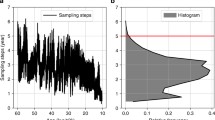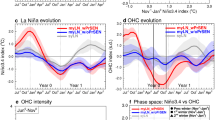Abstract
By merging reconstructed phenological series from published articles and observations of China Phenology Observation Network (CPON), the first blooming date of Amygdalus davidiana (FBA) in Beijing between 1741 and 2000 is reconstructed. The Butterworth method is used to remove the multi-year variations for generating the phenological series of annual variations in the first blooming date of A. davidiana. The extreme delay years in the phenological series are identified using the percentage threshold method. The characteristics of the extreme delays and the correspondence of these events with natural forcings are analysed. The main results are as follows. In annual phenological series, the extreme delays appeared in single year as main feature, only A.D.1800–1801, 1816–1817 and 1983–1984 were the events of two consecutively extreme years. Approximately 85% of the extreme delays occurred during 1–2 years after the large volcanic eruptions (VEI ≥ 4) in the eastern rim or the western rim of the Pacific Ocean, as the same proportion of the extreme delays followed El Niño events. About 73% years of the extreme delays fall in the valleys of sunspot cycles or the Dalton minimum period in the year or the previous year. According to the certainty factor (CF), the large eruptions have the greatest influence to the extreme delays; sunspot activity is the second, and ENSO is the last one. The extreme phenological delayed year is most likely to occur after a large eruption, which particularly occurs during El Niño year and its previous several years were in the descending portion or valley of sunspot phase.




Similar content being viewed by others
References
Alexander KE, Leavenworth WB, Willis TV, Hall C, Mattocks S, Bittner SM, Klein E, Staudinger M, Bryan A, Rosset J, Carr BH, Jordaan A (2017) Tambora and the mackerel year: phenology and fisheries during an extreme climate event. Sci Adv 3:e1601635. https://doi.org/10.1126/sciadv.1601635
Bridgman HA, Oliver JE (2006) The global climate system: patterns, processes, and teleconnections. Cambridge University Press, Cambridge
Christoper H, Thompson DJ, French GC, Harvey IF (2007) Historical changes in the phenology of British Odonata are related to climate. Glob Chang Biol 13:933–941
Chuine I, Yiou P, Viovy N, Daux V (2004) Historical phenology: grape ripening as a past climate indicator. Nature 432:289–290
Cleland EE, Chuine I, Menzel A, Mooney HA, Schwartz MD (2007) Shifting plant phenology in response to global change. Trends Ecol Evol 22:357–365
Cole-Dai J, Ferris D, Lanciki A, Savarino J, Baroni M, Thiemens MH (2009) Cold decade (AD 1810–1819) caused by Tambora (1815) and another (1809) stratospheric volcanic eruption. Geophys Res Lett 36:L22703
Easterling DR, Meehl GA, Parmesan C, Changnon SA, Karl TR, Mearns LO (2000) Climate extremes: observations, modeling, and impacts. Science 289:2068–2074
Fang XQ, Chen FH (2015) Plant phenology and climate change. Sci China Earth Sci 58:1043–1044
Fitter AH, Fitter R (2002) Rapid changes in flowering time in British plants. Science 296:1689–1691
Ge QS, Zheng JY, Tian YY, Wu WX, Fang XQ, Wang WC (2008) Coherence of climatic reconstruction from historical documents in China by different studies. Int J Climatol 28:1007–1024
Gergis JL, Fowler AM (2009) A history of ENSO events since a.D. 1525: implications for future climate change. Clim Chang 92:343–387
Global Volcanism Program (2013) Volcanoes of the world, v. 4.6.4. Venzke E (ed) Smithsonian Institution. Downloaded 13 Aug 2017. https://doi.org/10.5479/si.GVP.VOTW4-2013
Gong GF, Zhang PY, Zhang JR (1984) The variation of phenodate in Beijing district. Kexue Tongbao 12:1650–1652
Gouirand I, Jury MR, Sing B (2012) An analysis of low- and high-frequency summer climate variability around the Caribbean Antilles. J Clim 25:3942–3952
Guevara-Murua A, Williams CA, Hendy EJ, Rust AC, Cashman KV (2014) Observations of a stratospheric aerosol veil from a tropical volcanic eruption in December 1808: is this the unknown ∼1809 eruption. Clim Past 10:1707–1722
Hao ZX, Sun D, Zhang XZ, Zheng JY (2016) Regional differences in temperature response in China to the large volcanic eruptions since the 20th. Prog Geogr 35:331–338 (in Chinese)
Hathaway DH, Wilson RM (2004) What the sunspot record tells us about space climate. Sol Phys 224:5–19
Heckerman D (1986) Probabilistic interpretation for MYCIN’s certainty factors. Proceedings of the first conference on uncertainty in. Artif Intell 4:167–196
IPCC (2012) Managing the risks of extreme events and disasters to advance climate change adaptation, A Special Report of Working Groups I and II of the Intergovernmental Panel on Climate Change. Cambridge University Press, Cambridge
IPCC (2013) Climate change 2013: the physical science basis. Cambridge University Press, Cambridge
Jia PQ, Shi GY (2001) Study on the effects of volcanic eruption and solar activity on climate in China in recent 50 years. Plateau Meteorol 20:225–233 (in Chinese)
Körner C, Basler D (2010) Phenology under global warming. Science 327:1461–1462
Li CY (1989) El Nina event and the temperature anomalies in eastern China. J Trop Meteorol 5:210–219 (in Chinese)
Li ZZ, Liu XM, Chen XL, Jiang XY, Lei GL, Zhu Y, Jin JH, Hu FG (2012) Discussion on the uncertain development tendency of extreme climate events in future. J Subtrop Resour Environ 7:12–20 (in Chinese)
Liu Y, Fang X (2017) Reconstruction of spring phenology and temperature in Beijing, China, from a.D. 1741 to 1832. Int J Climatol 37:5080–5088
Liu YC, Dai JH, Wang HJ, Ye Y, Liu HL (2016) Phenological records in Guanzhong area in Central China between 600 and 902 AD as proxy for winter half-year temperature reconstruction. Sci China Earth Sci 59:1827–1833
Menzel A (2003) Plant phenological anomalies in Germany and their relation to air temperature and NAO. Clim Chang 57:243–263
Miller-Rushing AJ, Inouye DW, Primack RB (2008) How well do first flowering dates measure plant responses to climate change? The effects of population size and sampling frequency. J Ecol 96:1289–1296
Oppenheimer C (2003) Climatic, environmental and human consequences of the largest known historic eruption: Tambora volcano (Indonesia) 1815. Prog Phys Geogr 27:230–259
Pei Q, Zhang DD, Lee HF, Li GD (2014) Climate change and macro-economic cycles in pre-industrial Europe. PLoS One 9:e88155
Peñuelas J, Filella I (2001) Responses to a warming world. Science 294:793–795
Pinto JP, Turco RP, Toon OB (1989) Self-limiting physical and chemical effects in volcanic eruption clouds. J Geophys Res 94:11165–11174
Robock A (2000) Volcanic eruptions and climate. Rev Geophys 38:191–219
Ropelewski CF, Halpert MS (1989) Precipitation patterns associated with the high index phase of the southern oscillation. J Clim 2:268–284
Shortliffe EH, Buchanan BG (1975) A model of inexact reasoning in medicine. Math Biosci 23:351–379
Stothers RB (1984) The great Tambora eruption in 1815 and its aftermath. Science 224:1191–1198
Suppiah R, Hennessy KJ (1998) Trends in total rainfall, heavy rain events and number of dry days in Australia, 1910–1990. Int J Climatol 18:1141–1164
Usoskin IG (2017) A history of solar activity over millennia. Living Rev Sol Phys 14:3
Wang HJ, Ge QS, Rutishauser T, Dai YX, Dai JH (2015) Parameterization of temperature sensitivity of spring phenology and its application in explaining diverse phenological responses to temperature change. Sci Rep 5(5):8833
Zhang FG, Zhang XG (1994) The relation between large volcanic eruption in the world and the drought/flood in summer in China. J Nat Dis 3:40–46 (in Chinese)
Zhang XZ, Ge QS, Fang XQ, Zheng JY, Fei J (2013) Precipitation variations in Beijing during 1860–1897 AD revealed by daily weather records from the Weng Tong-he diary. Int J Climatol 33:568–576
Zheng J, Zhong S, Quansheng GE, Hao ZX, Zhang XZ, Ma X (2013) Changes of spring phenodates for the past 150 years over the Yangtze River Delta. J Geogr Sci 23:31–44
Zheng JY, Hao ZX, Fang XQ, Ge QS (2014) Changing characteristics of extreme climate events during past 2000 years in China. Prog Geogr 33:3–12 (in Chinese)
Zheng JY, Liu Y, Ge QS, Hao ZX (2015) Spring phenodate records derived from historical documents and reconstruction on temperature change in Central China during 1850-2008. Acta Geograph Sin 70:696–704 (in Chinese)
Zhu KZ, Wan MW (1980) Phenology. Chinese Science Press, Beijing (in Chinese)
Acknowledgements
This research was supported by the National Natural Science Foundation of China (NSFC; project number 41430528). We are grateful for the data support by China Phenology Observation Network (CPON), Global Volcanism Program, Marshall Space Flight Center and China Meteorological Data Service Centre. We also thank the editor and two reviewers’ suggestions for helping us improve our article.
Author information
Authors and Affiliations
Corresponding author
Rights and permissions
About this article
Cite this article
Liu, Y., Zhang, M. & Fang, X. Extreme phenophase delays and their relationship with natural forcings in Beijing over the past 260 years. Int J Biometeorol 62, 1229–1239 (2018). https://doi.org/10.1007/s00484-018-1528-0
Received:
Revised:
Accepted:
Published:
Issue Date:
DOI: https://doi.org/10.1007/s00484-018-1528-0




